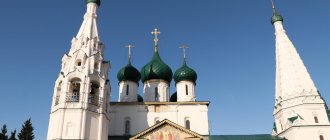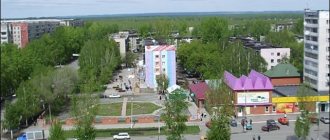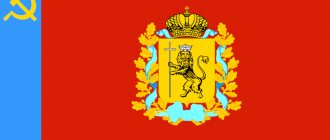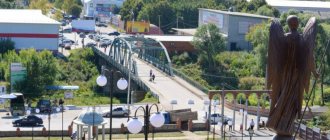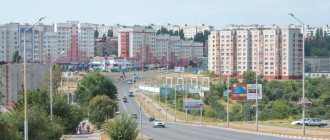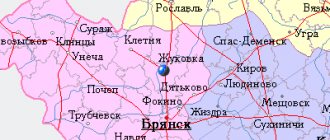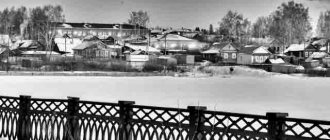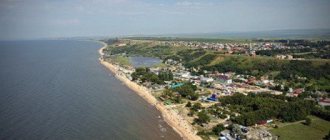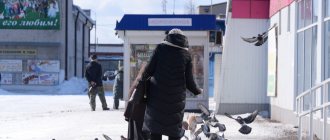Klimovsk became part of Podolsk in 2015. Still, the comfort of living and the real estate market should be considered separately. This city-district is located separately and has its own infrastructure. The portal KVARTIRAzaMKAD.ru studied new buildings in Klimovsk and compared it with other areas of Podolsk.
Klimovsk is located outside Podolsk in the south of the Moscow region, 22 km from the Moscow Ring Road along the Warsaw or Simferopol highway. The area of Klimovsk is 1,625 hectares, and the population in 2015 was 56 thousand people. According to these indicators, the newly-minted microdistrict is ahead of some self-sufficient cities in the Moscow region.
Borders and coat of arms of Klimovsk
Transport accessibility of Klimovsk
Residents of Klimovsk have both advantages and disadvantages in terms of convenient transport accessibility.
In fact, getting to Moscow is further and longer, but from Klimovsk there is a convenient exit to the Simferopol highway. You don’t have to get into traffic jams in Podolsk and Warsaw highway. Travel time to the Moscow Ring Road is from 30 minutes. Of course, during rush hours the key junction of Klimovsk gets clogged. Here, motorists from the Simferopol highway and from the center of Podolsk are connected in one highway.
Within the borders of Klimovsk there is only one railway station, Grivno. From the northern quarters it is more convenient to get to Vesennyaya station. Residents have one small advantage over Podolsk residents - electric trains from Lvovsk and Chekhov arrive to them less loaded, and there is an opportunity to take a seat. True, fewer trains themselves pass through Klimovsk per day than depart from Podolsk. The nearest Moscow metro station is Tsaritsyno station, a 40-minute drive from Grivno.
Railway station Grivno
Inside the city, residents say that in the morning there are streets. Factory and moving near Hryvnia. Recently, the accumulation of trucks near Berezhkovsky Proezd near Leroy Merlin became an acute problem. Drivers chose this area as a free parking lot and turned the already narrow street into a difficult place to pass.
Public transport is quite well developed. The most popular routes are to the Grivno station and the Globus hypermarket, from where minibuses go to almost all quarters of Klimovsk. From the center of Klimovsk to the center of Podolsk you can get by minibus or bus in 40 minutes.
Bus terminal near the station
Education[ | ]
| This section is excessively long or contains unimportant details. If you do not agree with this, please show in the text the materiality of the material presented. Otherwise, the section may be deleted. Details may be on the talk page. |
There are seven day schools in Klimovsk (4,616 students in 2008, 356 teachers), one evening school (63 students in 2008) and one correctional school (52 students in 2008). In addition, 98 subject clubs are open.
In 2009, 4,947 students studied in city schools, and 189 classes were opened. The average class size was 25.5 people. In 2009, 2,183 children received education in the city’s preschool institutions (72% of the total number of Klimov preschool children). 446 kindergarten graduates entered first grade. 193 children did not attend kindergartens due to a shortage of places in preschool institutions[34].
In May 2010, Klimov schools graduated 11 eleventh grades with a total of 277 students, 20 ninth grades (508 students)[35] and eight ninth-graders from a special school.
Among the city’s teachers, there are more than 60 honorary workers of general education of the Russian Federation, six honored workers of education of the Moscow region, four people have the title “Honored Teacher of Russia.” The city employs 17 laureates of the personal award of the governor of the Moscow region and more than 60 laureates of the personal award of the head of the city of Klimovsk[32]. It is planned to renumber schools that coincide with the main part of the city of Podolsk
School No. 1[ | ]
School No. 1 is the oldest educational institution in the city. It appeared in the century before last - in 1888. Until 1976, it was an eight-year-old building and was located on Shkolnaya Street in two buildings, one of which has survived to this day. In 1976, a new three-story block building was built on Roshchinskaya Street. As of 2012, more than 1,280 people are studying at the school. All classrooms of the school are staffed, furnished and equipped with the latest technology [ source not specified 995 days
].
Since 2006, it has the status of an experimental platform for the implementation and use of innovative educational programs, including information technologies. The primary school carries out educational activities according to the adapted standard programs “Planet of Knowledge” and “School 2100”. The school was awarded the honorary badge “For services to the city, II degree.”
Lyceum (school No. 2)[ | ]
Opened in 1960 as an eight-year school. Lyceum status was awarded in 2003. 1960 - year of foundation of the Klimov eight-year school 1962 - year of foundation of the Klimov secondary school No. 2 1997 - opening of a branch of the elementary school, expansion of the educational institution 1998 - assignment to the school of the status of a school with in-depth study of subjects 1998 - assignment of an honorary title “School of the Year - 98” for creative search, successful training and education 2000-2003. — work on the experiment “Development and implementation of new technologies” 2001 — assignment to the institution of the public status “School of Developmental Education” 2001-2002. — The school is the absolute winner of subject Olympiads in the city in 2003 — assignment to the educational institution of the status of a lyceum 2005 — confirmation by the lyceum of the public status “School of Developmental Education” 2005 — the lyceum took 1st place in the regional competition “For the best educational and material base of civil defense among educational institutions of the Moscow region" 2006 - Lyceum - winner of the priority national project "Education" 2006 - The lyceum became an experimental site of the International Association for Developmental Education 2007 - Lyceum - pilot basic school of the regional comprehensive project for the modernization of education 2008 - 1st place in the regional review-competition for the best life safety classroom 2008 - Lyceum - laureate (1st place) of the regional local history conference of students of the Moscow region in the category "Cultural Heritage" 2008 - Lyceum - participant in testing a model remuneration system within the framework of a regional comprehensive education modernization project 2011 - Lyceum - cathedral basic educational institution of the State Educational Institution Pedagogical Academy of Postgraduate Education 2012 - Lyceum - autonomous educational institution 2014 - Lyceum - Municipal budgetary educational institution
School No. 3[ | ]
On September 1, 1938, school No. 3 in Klimovsk, the only secondary school in the city at that time, accepted its first students. Before the Great Patriotic War, the school had two graduations, in 1940 and 1941. Many graduates wanted to continue their education and were going to enter universities. But the outbreak of war left them no choice. Almost all the boys and many girls went to the front. Teachers were also called up: Dmitry Fedorovich Sknarin, Nikolai Fedosevich Oseledko, and later the school director Lev Borisovich Khmelnitsky. Classes at school, although with interruptions, continued. The remaining high school students after school were sent, by decision of the City Executive Committee of November 27, 1941 (document No. 2, p. 11), to defense work: they took part in the construction of defensive structures, in clearing snow on the railway and highway, in collecting firewood for steam locomotives. In 2013, the school celebrated its 75th anniversary, especially for which all the windows in the building were replaced with modern ones made of PVC, the facade was redecorated, and a porch with a canopy appeared.
Gymnasium named after Podolsk cadets (School No. 4)[ | ]
| This section is excessively long or contains unimportant details. If you do not agree with this, please show in the text the materiality of the material presented. Otherwise, the section may be deleted. Details may be on the talk page. |
Museum of Podolsk gymnasium cadets.
Fragment of the exhibition (School No. 6) The gymnasium is the legal successor of secondary school No. 4, and also, according to the facts, the PPU school, opened on February 27, 1938. Initially, the school was located in a barracks on modern street. Dm. Kholodova (formerly February). After the Great Patriotic War, the school moved to the street. Zavodskaya 4b, where vocational school No. 78 is currently located. In 1974, a new building was built on 50th Anniversary of October Avenue, 18, where to this day more than a thousand young Klimov residents are trained and educated.
Patriotic education is included as a separate line in the educational activities of the school. The work of students and teachers to perpetuate the feat of the Podolsk cadets was noted at the all-Union level. And in 1988, by order of the Council of Ministers of the RSFSR, secondary school No. 4 was named after the Podolsk cadets.
The status of a gymnasium was awarded in 1996, at the same time the educational institution was recognized as the best school in the Moscow region.
The gymnasium named after Podolsk cadets was awarded memorable insignia:
1. “Veteran of Podolsk military schools. October 1941" (1995)
2. “For services to the city” 2nd degree (2013)
School No. 5[ | ]
Opened in 1959. Municipal educational institution Secondary School No. 5 with in-depth study of individual subjects [ which ones?
] is named after Dmitry Kholodov, who studied there.
School No. 6[ | ]
The educational institution began its work on September 1, 1966.
School No. 7[ | ]
Started work on September 1, 2022.
Ecology of Klimovsk
Ecology is Klimovsk’s main trump card in the dispute with Podolsk about the comfort of life. There are no serious sources of pollution, but there are two rivers and green parks in different parts of the city. The eastern part is a little less fortunate - there is higher car traffic here due to the proximity to the Globus and Leroy Merlin hypermarkets and the presence of an industrial zone.
Park of Culture and Recreation "Dubrava" and r. Petritsa
The inclusion of Podolsk made it possible to solve long-standing problems with water quality and cleaning of the Petritsa River.
R. Petritsa
Geography[ | ]
The Klimovsk district is located in the southern part of the city of Podolsk. The railway line is divided into two parts - eastern (Vesennyaya) and western (Grivno). Surrounded by forests. The district includes the Dubrava park. The height of the center above sea level is 175 m.
| Nearest cities (as the crow flies) | ||
| North-west: Troitsk 19 km | North: Podolsk 1.5 km | Northeast: Domodedovo 17 km |
| West: Naro-Fominsk 48 km | East: Bronnitsy 47 km | |
| South-west Balabanovo 58 km | South: Chekhov 25 km | South-east: Mikhnevo 38 km |
The Rozhai (Sosnovka) and Petritsa rivers flow through the territory of Klimovsk. The area is located on the watershed of the Mocha and Rozhaika rivers, which are the first-order right tributaries of the Pakhra River. Klimovsk is located on the Moskvoretsko-Oka Plain, in the center of the East European Plain. The climate is moderate continental with relatively mild winters and warm, humid summers. The average January temperature is about −10, the average July temperature is +17 °C. The average length of summer is 130 days. Frequent passage of cyclones from the Atlantic and sometimes from the Mediterranean causes an increase in cloudiness. The average annual precipitation is 550 mm. The most precipitation falls in summer, the least in winter. The average thickness of the snow cover in winter is 8-10 cm. The air is not very polluted; before the construction of the overpass, the highest concentration of harmful gases was in the area of the Sergeevsky railway crossing.
There is no mining of natural resources, but on the south-eastern outskirts of Klimovsk there is a deposit of clays and fusible loams for bricks.
The forests around Klimovsk are home to squirrels, snakes and other animals. Birds are widespread (woodpeckers, tits, sparrows, bullfinches, pigeons, crows, rooks, magpies, etc.).
Infrastructure of Klimovsk
Klimovsk is trying to remain a self-sufficient city. True, now the situation is changing a little towards the centralization of Bolshoi Podolsk. For example, the local emergency room recently closed, forcing residents to go to the Podolsk department.
There is 1 ambulance station and two city hospital branches in Klimovsk. They have clinics and children's departments. There is another children's clinic located separately. There are 4 dentists in the city, an outpatient clinic and a private diagnostic center. There is a boarding house where the elderly and disabled are cared for.
Boarding house for the elderly and disabled
Of the educational institutions in Klimovsk, there are 8 public schools, including the Podolsk Cadets Gymnasium, a lyceum and an evening school. There are few kindergartens in Klimovsk - only 11. Most are located in the eastern half of the city. But there are many developmental centers for children, clubs, sections and private educational institutions. There are two art schools, a music school and a martial arts school.
School No. 1 in Klimovsk
Residents have many opportunities for sports. Klimovsk has 3 stadiums, a boat station and a range of sports sections and fitness rooms.
In addition to the main hypermarkets Globus and Leroy Merlin, residents have access to several small shopping centers. Many people go shopping at the Metro Cash&Carry hypermarket, located on Simferopol highway, 6 km from Klimovsk.
Hypermarket "Globus" in Klimovsk
The city has two entertainment centers, the House of Culture with a cinema and an amusement park.
The Mashinostroitel House of Culture looks dilapidated
WWII Memorial
Shopping center "Chameleon"
History of development
On the site of the modern city there was once the village of Klimovka, the development of which was due to communication routes: first the Moscow-Serpukhov-Tula road, and then the railway in the same direction.
At the end of the 19th century, the Mechanical Products Association allocated money for the construction of a plant for the production of looms in Klimovsk. As often happens, a workers’ settlement began to form around the plant, and subsequently (since 1940) the city of Klimovsk.
Automatic weaving looms are still produced in Klimovsk, along with them, the city has developed agricultural engineering, the food industry, and there is a toy factory.
Urban environment of Klimovsk
Residents are not indifferent to the appearance of the city and actively fight for its improvement and order. Gradually, Klimovsk is becoming more comfortable to live in. Even if not immediately, we manage to get the administration to solve pressing problems.
For example, it is planned to build an underground passage at the Grivno station - a necessary project for the city. Now residents have to overcome the steep ascent and descent along broken stairs. This is a particularly big problem for mothers with strollers and older people.
So far, Klimovsk welcomes guests very modestly. Many buildings look shabby, and there are few modern buildings. You can see abandoned buildings gaping with empty windows. The city is not suitable for people with disabilities.
Children's playground in one of the residential areas
Abandoned building
Unfinished object: either a residential building or a store
The official website of Klimovsk ceased to exist after the annexation. Administrative news is covered by the city portal. Current events, happy and sad news can be found out “unvarnished” in social groups. networks.
Industry[ | ]
| This section is excessively long or contains unimportant details. If you do not agree with this, please show in the text the materiality of the material presented. Otherwise, the section may be deleted. Details may be on the talk page. |
As of January 1, 2010, 217 industrial and scientific organizations operated on the territory of the municipality. The main types of products: polymer pipes and connecting parts, pumps, compressors and equipment for them, plastic windows and doors, food products, fasteners, plastic consumer goods, paper, cardboard, furniture, defense products[34].
Scientific developments and design and survey work in the city are carried out by:
- Central Research Institute of Precision Engineering (development of weapons models);
- LLC "KBAL im. L. N. Koshkin" (Design Bureau of Automatic Lines named after Lev Nikolaevich Koshkin);
- STC "Version";
- CJSC "Bi-west"
City enterprises:
- Klimovsky Specialized Cartridge Plant (ammunition production);
- (production of pumps and pumping equipment);
- Klimovsky Pipe Plant;
- Klimovsky paint and varnish plant;
- Klimovsky Experimental Plant;
- Factory of wooden toys "Klimo".
- Klimovsky Coin Preparation Plant LLC "GURT"
Secondary market of Klimovsk
As of May 2022, the secondary market in Klimovsk has the largest supply of brick houses. These are mostly old five-story buildings with peeling paint in the entrances. Their prices depend on the number of floors and location. In houses on the avenue. 50 years of October price tag 70 – 83 thousand rubles. per sq. m. In the western part of the city, the price can drop to 64 thousand rubles per sq. m. m.
Apartments on the secondary market in Klimovsk
Multi-storey brick houses are more valuable - here the price is per square meter. m. in Klimovsk from 80 thousand rubles. There is even a brick house built in 2005, where sq. m. in a one-room apartment costs 101 thousand rubles.
You can buy an apartment in Klimovsk in a monolithic brick building only on the street. Sovetskaya 11 and the Triumph residential complex, commissioned in 2010. These are some of the best offers on the city’s secondary market. Prices range from 80 to 92 thousand rubles per sq. m. m. Here you can buy a studio in Klimovsk. In addition, you often come across offers with good repairs. The downside is the unhurried construction of two buildings of the residential complex “Ul. Sovetskaya 18" next door, which is scheduled to be completed at the end of 2018.
Buy an apartment in the Triumph residential complex
You can buy an apartment in a panel house in Klimovsk on the street. Molodezhnaya (from 95 thousand rubles per sq. m) and st. March 8 (from 71 thousand rubles per sq. m).
It is not difficult to buy a two-room apartment in Klimovsk, just like one-room apartments; there is a large selection of them here. There are slightly fewer three-room apartments on the market, and there are almost no offers for the sale of multi-room apartments.
Apartments in the eastern part of the city are more valuable due to their developed infrastructure: proximity to hypermarkets and entertainment centers. There are many child care facilities here, so it will be a little easier to place a child. In the western part of Klimovsk there are many times fewer schools and kindergartens, and they are heavily loaded. But the environment is better here and there are more parks for walking and sports.
Prices on the secondary market in Klimovsk, oddly enough, are comparable to apartments in Podolsk. The best local deals may even be higher than the price tag of the alternative in Podolsk.
Population[ | ]
| Population | ||||||
| 1926[13] | 1931[13] | 1939[14] | 1959[15] | 1967[13] | 1970[16] | 1971 |
| 200 | ↗3300 | ↗10 913 | ↗29 478 | ↗37 000 | ↗42 856 | ↗44 800 |
| 1979[17] | 1982[18] | 1986[13] | 1987[19] | 1989[20] | 1992[13] | 2000[13] |
| ↗53 926 | ↗55 000 | ↗57 000 | →57 000 | ↘56 720 | ↗57 500 | ↘55 400 |
| 2001[13] | 2002[21] | 2003[13] | 2005[13] | 2006[13] | 2009[22] | 2010[23] |
| ↘55 100 | ↗55 644 | ↘55 600 | ↘55 400 | ↘55 300 | ↗56 002 | ↗56 186 |
| 2011[13] | 2012[24] | 2013[25] | 2014[26] | 2015[2] | ||
| ↘56 160 | ↗56 440 | ↘56 207 | ↘56 206 | ↗56 239 | ||
Demography
The dynamics of demographic indicators are presented in the table:
| The section lacks links to sources. Information must be verifiable or it may be deleted. You can edit the article to add links to authoritative sources. This mark was set on September 23, 2015 . |
| Year | Died(persons) | Born(persons) | Migration result | Growth |
| 2000 | 922 | 338 | +300 | -284 |
| 2001 | 1072 | 358 | +609 | -105 |
| 2002 | 1028 | 429 | +329 | -270 |
| 2003 | 1037 | 449 | +312 | -276 |
| 2004 | 1029 | 431 | +389 | -209 |
| 2005 | 1056 | 463 | +562 | -31 |
| 2006 | 999 | 418 | +683 | +102 |
| 2007 | 973 | 490 | +1100 | +483 |
| 2008 | 957 | 570 | n.data | n.data |
| 2009 | 937 | 553 | n.data | n.data |
| 2010 | 951 | 606 | n.data | n.data |
| 2011 | 843 | 573 | 560 | +290 |
| 2012 | 879 | 592 | 43 | -244 |
The Klimovsk Employment Center provides the following data (Klimovsk city district as of January 1, 2013) Population - 56,077 people Economically active population - 32,413 people Employed population - 29,781 people Number of unemployed citizens - 158 people Number of vacancies - 518 Average monthly salary for 2012 - 22,187 rubles.
Review of new buildings in Klimovsk
As of May 2022, there are 4 residential complexes under construction in Klimovsk. Basically, this is infill development without its own social infrastructure.
Developers are actively developing land near the village. Podolsk MIS. The new microdistrict is located within walking distance from Grivno station. From here it is convenient to get to hypermarkets and use social infrastructure. In the neighborhood there is a Podolsk machine testing station and a boarding house for pensioners and disabled people, and opposite is a village with private houses.
The Estet residential complex is being built here - one of the largest and most famous new buildings in Klimovsk. At the same time, the project has enough “weak points”. The developer, Premier Development LLC, has been postponing the completion date for two years now, causing the righteous anger of shareholders.
Now the commissioning of houses and the issuance of keys are scheduled for mid-2022, and three monolithic buildings are almost ready. Residential complex "Estet" is a classic example of a new economy class building. No school, no kindergarten, no parking. Even the first floors in a couple of buildings are residential.
One- and two-room apartments predominate in the Estet residential complex. The price tag is quite affordable: 46-51 thousand rubles per sq. m. m. The cheapest studio will cost 1.3 million rubles. On average, the price range is 1.7 - 3.6 million rubles, depending on the number of rooms and location.
Construction progress of the Estet residential complex
A residential complex “On Serpukhovskaya Street 3A” is being built nearby from the developer JSC “TEKS”. This is a 17-story monolithic building. Its construction began in 2013. and was supposed to be completed in 2016. However, the deadline has been postponed to the 3rd quarter of 2022. It also does not provide its own infrastructure, not counting the local amenities.
It is curious that the project provides only studios, one-room apartments and two-room apartments. The latter are no longer available. The price tag as of May 2017 is 55 thousand rubles. per sq. m. The cost of a “one-room apartment” in a new building in Klimovsk in the residential complex “On Serpukhovskaya Street” is 3.0 – 3.2 million rubles.
Residential complex "On Serpukhovskaya Street"
CJSC TEKS is building another residential project in Klimovsk. Construction of the residential complex “Ul. Sovetskaya 18" began in the 1st quarter of 2016, but so far there are only conditional outlines of future houses on the site. Delivery is scheduled for the end of 2022. There are 2 monolithic brick buildings with a predominant number of two-room apartments planned here. You can also buy a three-room apartment in a new building in Klimovsk.
Cost per sq. m. in the residential complex "Ul. Sovetskaya 18" is 50 thousand rubles. per sq. m. Among the amenities - only the local area without social services. infrastructure. The residential complex is being built next to the Triumph residential complex, within walking distance of the railway station and the Dubrava city park.
Construction site of the residential complex "Ul. Sovetskaya 18"
The Alliance residential complex is being built in the western part of Klimovsk. These are 2 monolithic brick buildings, the delivery of which is scheduled for the end of 2017 - beginning of 2022. The developer LLC Zhilsotsstroy offers for sale only one-room apartments and two-room apartments. Price tag from 48 thousand rubles per sq. m. m. in house No. 43, and from 57 thousand rubles. per sq. m. in house No. 41, which is 70% ready. From here it is a bit far to the railway station and main infrastructure. But there is a forest park, a river and a sports stadium nearby.
Construction progress of the Alliance residential complex
The primary market is dominated by a range of one-room apartments. You can buy a two-room apartment in a new building in Klimovsk, but the choice is smaller and the demand is high.
Economics[ | ]
The total economic turnover in the city in 2009 amounted to 16.1 billion rubles compared to 13.9 billion rubles in 2008 (+15.1%)[32].
In 2010, the total economic turnover amounted to 21.5 billion rubles (an increase compared to 2009 - 23.3%)
In 2009, the city budget received 1,137.5 million rubles (+35.9% compared to 2008). The income plan was fulfilled by 98.5%. The main revenue source of the city budget in 2009 was the personal income tax - 261.28 million rubles (2008 - 183.1 million rubles). Budget expenditure obligations were fulfilled in the amount of 1,198.13 million rubles (2008 - 932.97 million rubles). The main share was made up of expenditures on education - 38.7%, healthcare, physical education and sports - 37.2%, housing and communal services - 5.2%, social policy - 5.2%, culture, cinematography - 5.5 %. As of January 1, 2010, the municipal formation “Klimovsk City District” had no debt obligations[34].
In the real sector of the economy, 7,043 people worked in 2009; in the budgetary sector of the economy, the average number of workers was 3,551 people[34]. In the city as a whole, in 2009 the number of employees increased by 1.8% compared to 2008 and amounted to 15.6 thousand people[32].
Impressions and conclusions
For residents of Klimovsk, the quality of city life is gradually increasing: commercial infrastructure is developing, road and engineering problems are being solved.
A big disadvantage of buying an apartment in Klimovsk is the overloaded social infrastructure, especially children's institutions. Developers refer to proximity to a particular facility, without specifying that it alone serves all surrounding neighborhoods. None of the developers have provided their own infrastructure, the first floors are residential, parking is spontaneous at home, apartments are sold unfinished. By all indications, the real estate market in Klimovsk is stuck in the “economy class” segment.
In Klimovsk, prices in new buildings are significantly lower than in Podolsk. This could be a strong argument in favor of Klimovsk, despite the problem with social services. infrastructure.
The main advantage of Klimovsk still remains its good ecology, opportunities for sports and walks in the large park areas of the city.
Families with children are better off choosing an apartment in the northern part of the city, where there are more preschool and educational institutions. These are the neighborhoods in the vicinity of the avenue. 50 Let Oktyabrya and st. Factory.
For those who want to move to a quiet and environmentally friendly area, the western part of Klimovsk is suitable.
Symbolism[ | ]
The city's coat of arms and flag were approved on April 12, 2008. The idea of the coat of arms belongs to Nikolai Klimov. The content of the flag is similar to the coat of arms. The coat of arms and flag are two-colored - blue at the top and red at the bottom. On a red background, two weaving shuttles emerge from both sides. An open book is depicted on a blue background. The previously existing coat of arms was adopted on October 31, 1977. At the top of the coat of arms there was a gold inscription Klimovsk on a red background; on a red background at the bottom there was a part of a gear, and inside it were weaving shuttles. All parts of the coat of arms were separated by a gold frame. Otherwise the coat of arms was similar to the new one.
The anthem of Klimovsk was adopted on May 15, 2002. The author of the text is Emma Lozovskaya, the author of music is Stanislav Garnovsky.
Comfort level in Klimovsk 12.2 out of 20
| Environmental characteristics | ||
| Green areas | 4 | 4.0 |
| Reservoirs | 4 | |
| Absence of serious sources of anthropogenic pollution | 4 | |
| Visual environment | 4 | |
| Connectivity of the city/region | ||
| Ease of movement within the city/region | 4 | 3.8 |
| Accessibility of Moscow by public transport | 4 | |
| Accessibility of Moscow by personal transport | 4 | |
| Communication with other localities | 4 | |
| Conditions for working within the city | 3 | |
| Social infrastructure | ||
| Kindergartens | 2 | 3.4 |
| Schools | 2 | |
| Children's leisure centers | 4 | |
| Cultural institutions | 4 | |
| Healthcare | 3 | |
| Sports and fitness | 5 | |
| Religious buildings | 3 | |
| Shopping and entertainment infrastructure | 4 | |
| Habitat quality | ||
| State of city utilities | 4 | 3.0 |
| Development of the real estate market | 3 | |
| Parking | 3 | |
| Accessibility for the disabled | 2 | |
| Risks and threats | ||
| Deteriorating transport situation | -2 | -2.0 |
| Underdevelopment of social infrastructure | -4 | |
| Deterioration of the environmental situation | -1 | |
| Oversaturation of the real estate market | -1 | |
"House of Culture named after May 1st"
The Stalinist building, decorated with a heavy colonnade, is a favorite place for all schoolchildren in the city. There are numerous interest groups working here. And it will be exciting for city guests to attend any concert or event held in the assembly hall of this attraction.
Location: street
Not far from the Petritsa River, a cross was erected and consecrated in 1997, and later the “Church of All Saints” was erected. The temple, small in size, is located in a picturesque place. The entire territory is fenced with a forged carved fence.
The facade is decorated with cornices and platbands, and angular pilasters add individuality. Some windows are decorated with pretty stained glass, and the interior decoration is grand and monumental. Nowadays, services, rituals and confessions are systematically held here.
Location: Vsekhsvyatskaya street - 1.
